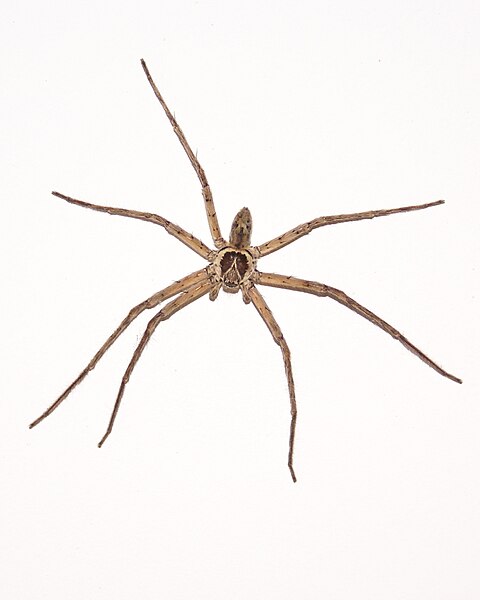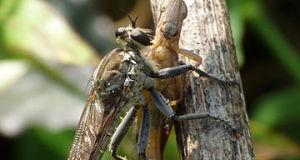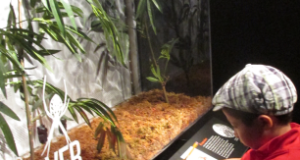As a boy, my favorite exotic animal collecting site was, of all places, the loading dock of the local A&P Supermarket. Raymond Ditmars and other famous city-born naturalists had taken this route, and so I followed. The store was not far from the Bronx’s Hunts Point Market, where trucks from all over delivered fresh produce. Hidden within the produce crates were the creatures I sought – tree frogs, spiders, lizards, insects and such (I once narrowly missed a Mouse Opossum). All large spiders were called “Banana Spiders”…one, the Giant Crab or Huntsman Spider (Heteropoda venatoria), appeared on occasion but was always too fast for me. I became obsessed with this beast, whose leg span approached 6 inches, but, try as I might, I remained crab spider-less.
Meeting Both a Long-Lost Spider and Entomologist

The spiders were faster than I remembered (and I was slower!)…those I captured had mainly fallen into places from which they could not escape. They proved surprisingly easy to breed and, once set up in our exhibit area, were very popular with our visitors.
I took a specimen to the American Museum of Natural History, where it was identified as Heteropoda venatoria. Amazingly, the woman who identified the spider for me was famed invertebrate specialist Alice Gray…while speaking, we discovered that it was she who had answered my mantis rearing questions when I called the museum as a boy, 25 years earlier!
Captive Care
These impressive spiders occasionally appear on the price lists of Florida-based reptile dealers, and they are quite inexpensive. If a few guidelines are followed, they make fascinating, active terrarium inhabitants, and breed readily. Once their amazing speed in hunting is seen in action, even die-hard tarantula fans cannot resist them!
I’ll cover the natural history and captive care of Huntsman Spiders in Part II of this article.
Further Reading
An interesting article on this spider’s life cycle is posted at on the website of the Cambridge Entomological Society.
Male Huntsman Spider image referenced from wikipedia and originally posted by B. Navez
 That Reptile Blog – Reptile, Amphibian and Exotic Pet Care and Information
That Reptile Blog – Reptile, Amphibian and Exotic Pet Care and Information




Hello,
I did not know that these spiders were being sold from dealers, how much did they cost?
Hello Jose, Frank Indiviglio here.
Thanks for your interest in our blog. I’ve seen them most often on the Glades Herp list; they are not bred and so only appear as collected, 1-2 at a time usually. Price last yr was $10. Check also the spider listings on Kingsnake.com – search under “Huntsman”, Giant Crab Spider” and “Heterapoda”.
Please let me know if you need any further information. Good luck, enjoy and please keep me posted.
Best regards, Frank Indiviglio.
Do you keep these spiders?
I only have one aggressive male which tends to bite any obstacle that moves it
Hello Jose, Frank Indiviglio here.
Thanks for your comment; I have kept them for many years, and there is a population established in a zoo building in which I worked. They are always as aggressive as you describe…please be careful, as there fangs can no doubt break human skin.
Please let me know if you need any further information. Good luck, enjoy and please keep me posted.
Best regards, Frank Indiviglio.
Last year, there was a huge population at our place, I see their shed skin hanging on old houses. I have seen huge ones at our house especially on the bathroom when they go inside houses to look for some prey they can feed on.
There was a time that the bathroom was overrun by huntsman spider babies, they were roaming around and I even saw the mother beneath the washing machine. I also seen these spiders on the rock piles around the garden.
Hello Jose, Frank Indiviglio here.
Thanks very much for the report. When you have a chance, please let me know where you are writing from. Also, I’m interested to hear that you’ve observed them on rock piles…was this on the ground or mare of a rock wall situation? I ask because I’ve only observed them on tree trunks or the side of building walls or large cliff sides within zoo exhibits.
Good luck, enjoy and please keep me posted.
Best regards, Frank Indiviglio.
2012 05 30: I just caught one of the male spiders in my garage before I found out what it was. He was very slow moving and possibly injured. Now I am looking for the female. My husband plans to spray everywhere to kill it as it seems unlikely we will be able to catch it. It is apparently under an old refrigerator that is not running. We don’t want to discover that there are 200 eggs hatched and a giant infestation of spiders in the house.
I hate to kill the captive male if there is someone who might want it, but they would have to come here to get it. The spider will probably die soon anyway because I have no intention of feeding it by catching cockroaches for it. If these are easy to breed I wouldn’t imagine anyone would want it, but I just thought I would ask. I live in Punta Gorda, Florida, 2 hours south of Tampa, across the bridge from Port Charlotte. If they managed to find my house in this neighborhood there must be a lot more of them around. Any suggestions?
Hello,
The males die shortly after maturing; if it is moving slowly then it is near the end of it’s time. You can humanely euthanize via freezing if you wish.
Presence of a one does not necessarily mean that there are others. They are established in Fla, but do not move in pairs or groups, so no need to be overly concerned.
Best regards, Frank
It seems they are taking over our home. We have killed at least 2 a week for several weeks now. I always thought they were wolf spiders. They are very large and quite intimidating. Any suggestions on keeping them out of the house?
Thanks
Hi Brandi,
Thanks for the info – pl let me know where you are located when you have a moment, I’m interested in tracking their range. Sorry there’s real way to repel them, as far as I know. Hatchlings are so tiny, they get in but often remain unnoticed/hidden until larger. Even at the BX Zoo, where thety are established in a few bldgs, they would show up in “bug proof” rooms somehow.
Best regards, Frank
Since huntsman spiders depend on cockroaches and similar bugs to eat, the best way to get rid of them is to get rid of their food supply and spray thoroughly for bugs in and around the house. However the local vector control in our county suggested that I leave the spiders alone and let them do the hunting for me and let them kill the cockroaches. I chose to spray for bugs to get rid of everything.
Hi,
Thanks for your input; yes, spraying will kill spiders and their prey. Unfortunately, keeping spiders about will not eliminate insect pests, given their different reproductive rates etc. Keeping spiders out of the home is another matter – very difficult due to the tiny sze of the hatchlings.
Best, Frank
Then it sounds like the important thing is to get rid of the spiders before more females hatch more offspring, since they get around 200 eggs at a time. Spraying sounds like the only option. Any other options?
Hi,
Yes, removing females is key; given the large clutches, finding 1-2 week prob means that a few are wandering in; not really an established population; when this happens, you see them all over. Spraying will kill what’s there if done well, but it is difficult to exclude others from entering. It’s usually recommended that prey be eliminated; this may help once spiders are inside (although they need very little food) but those that wander are not being drawn in by prey, just part of regular dispersal.
Best, Frank
Thanks for the info. I’m located in a small town called Montverde. It’s about 20 miles west of Orlando. I think they must just be wandering in as you said. We don’t have any other bugs in the home (except various kinds of spiders) but we do live in a wooded area so there are plenty outside. I actually spotted one last night outside the sliding glass door. He dinately looked liked he was trying to find a way in! It just seems we went from rarely spotting one inside to seeing them often. It is the same way with brown widows. Thankfully I have not found any of those indoors yet, but I never used to see those and they too are popping up everywhere. Along with wolf spiders. Two nights ago I sprayed one on the front porch and it released what seemed like hundreds of tiny babies.
Hi Brandi,
Thanks for the locale info. Interesting that they have spread that far; they apparently started out in Miami (as did many of our exotic species, especially reptiles and fish). Insects and spiders often go through cycles, population spikes and crashes. Sometimes it seems not to make sense (to us) as to the timing, but I’ve noticed similar cycles in many other species; i.e very few cicadas here in NY this year, despite months of nearly perfect weather/rain for them.
I’m assuming you know, but just in case – most spider bites occur when the animal is resting below on on something that is picked up; the hand touches the spider and it bites. Hard to grab Huntsman accidentally, given their speed, but easy to do with widows and others.
Please keep me posted. Best, Frank
Frank,
Again, thanks for the info. It is very interesting. I constantly check everything outside before I let my two year old play as I have found the widows under toys, chairs,etc. The big guys inside seem to come out at night and I am terrified that they we will be bitten while we are asleep. One night my husband woke up to a smaller spider crawling on him. When he turned the light on there were two more on the bed on top of the comforter!
Hi Brandi,
if adults are getting in, you might want to have a pro check the house perimeter, see if extra sealing/repair would be useful. Widows are a concern where kids are involved…might be wise to contact doctor and learn signs of bite, where is closest hospital with antivenin, procedure to follow if you know a bite has occurred etc.
Best, Frank
Thanks for the info. I just found a male on an outside wall last night. Gave me the creeps. Couldn’t believe his speed when I tried to catch him unsuccessfully.
Thanks for the feedback, Donna…I’ve worked with literally hundreds of species of spider…none tops this one! Best, Frank
I have a question. I caught My pet giant crab spider here in AZ. I found it in an old car during the winter, so it was really slow. Anyway, it recently died after a year and a half. I fed it crickets and watched it grow. It shed 4 times was eating just fine. Then I saw its opisthosoma getting smaller and smaller. I watered it regularly by dribbling water on the screen of its cage. The surface tension kept the water there and the spider would drink. What did I do wrong? It bothers me that feeding and watering it didn’t keep it alive.
Hello,
If it was the species described here (there are many that are similar) then you did fine…their life cycle is less than 2 years; especially true in an introduced environment, where winters are colder than they normally experience. Please see article linked under further reading for more on their lifespan, etc.
ZBest, Frank
We just found one in our bathroom, in Yankeetown, Florida. I count 7 legs, just like the one in your picture. Where is the eighth one?
Hello Steve,
They shed the legs when grabbed by an enemy, also lose them while chasing prey etc; the leg is generally replaced at the next molt….but as you’ve likely seen, they can move pretty well with 7 (or 6!), best, Frank
Hi Frank,
I really enjoy reading your blogs. Huntsman spiders are one of my favorite spiders, and we had the gold huntsman (Olios giganteus) about as a kid and often played with them. In Florida we had the H.venatoria. Fast indeed if they get spooked, but have corralled them by hand and save for some jumpers, seem content to just crawl on your hands. I have never had a bite from one but understand they are no more dangerous than a wasp sting. I don’t think they make the best pet spider as being active hunters and an affinity to chill on vertical surfaces like trees or walls, make proper caging impractical for the average keeper. I did keep one in captivity for a full 3 years before succumbing.
If you are still interested in their range, the O.giganteus can be found from mid Texas into southern California, and the H. venatoria from Texas to the east coast, north to south Carolina.
Thanks.
Hi Daniel,
Thanks for the kind words and observation…I can’t recall any living to 3 years, very good to have that information.
I always discourage folks from handling spiders…nothing in it for the animal, and while their venom is not known to be dangerous, allergies and underlying health concerns can change that. They and others have bitten when resting on hands, seemingly unstressed, in response to factors that we cannot sense. Best regards, frank